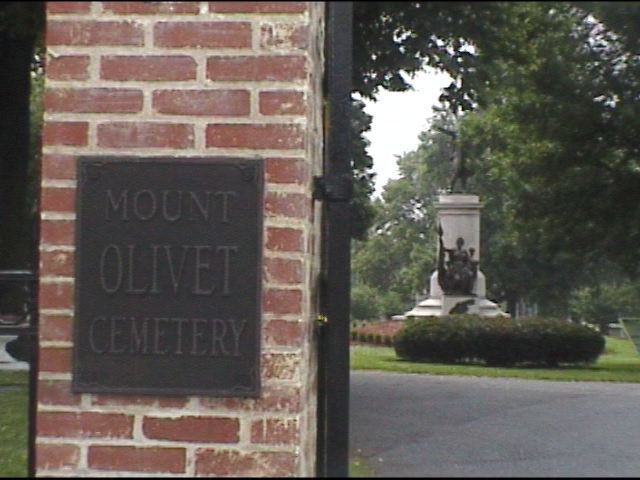Established 1854 (chartered) No. of graves 34,000+ Number of graves 34,000 | Country United States Phone +1 301-662-1164 | |
 | ||
Location 515 South Market Street, Frederick, Maryland Owned by Mount Olivet Cemetery Company, Inc. Website mountolivetcemeteryinc.com Address 515 S Market St, Frederick, MD 21701, USA Burials Francis Scott Key, Joseph C. O'Mahoney Similar Roads and Rails Museum, National Museum of Civil War, Weinberg Center, Scheifferstadt, Gambrill State Park | ||
Mount Olivet Cemetery is a cemetery in Frederick, Maryland. The cemetery is located at 515 South Market Street and is operated by the Mount Olivet Cemetery Company, Inc.
Contents
History
On October 4, 1852 a group of citizens from Maryland including Charles Edward Trail founded the Mount Olivet Cemetery Company. The company purchased 32 acres of land, which was designed by James Belden to incorporate walkways and driveways throughout the grounds. The cemetery was conceived primarily to provide several of the downtown Frederick churches more room for interments, after their cemeteries became full. Over time some of these smaller cemeteries were also relocated to Mount Olivet.One of the landmarks of Frederick, the episcopal graveyard, a family burying ground of some of the most famous personages of Maryland, was yesterday sold to G.L. Hughes. The plot where until about two years ago the first Governor of Maryland, Governor Thomas Johnson, rested, will soon be utilized for commercial purposes. All bodies were moved from the graveyard nearly two years ago to Mt. Olivet Cemetery.<"FNP 11/23/1915" /<
Initial shares were sold for US$20 with the intention that after the cemetery was laid out that each share would be exchanged for 12 grave lots. The cemetery was formally established (chartered) in 1954. Mrs. Ann Crawford was the first interment at the cemetery, she was buried on May 28, 1854.
Notable monuments and markers
Mount Olivet Cemetery has had many monuments constructed on the grounds since its establishment. These monuments honor significant historical people, events and the men and women who fought in many of the military conflicts the United States has been involved in.
Monument to the Unknown Confederate Soldiers
On August 7, 1879, a meeting was held to organize a group called the Ladies Monumental Association of Frederick County, whose purpose it was to raise the funds needed to erect a monument to the 40 ‘unknown’ deceased Confederate soldiers interred at Mount Olivet Cemetery. The monument was unveiled on June 2, 1881 to honor the soldiers of the Confederate army who fell in battles of the Civil War and who are buried at Mount Olivet Cemetery. The monument is 15 feet tall. The statue of the Confederate soldier was created in Italy of Carrara marble and stands upon a base made of granite. The inscriptions read as follows:
Front panel:”Erected A.D. 1880, by the Ladies’ Monumental Association of Frederick County, in honor of the soldiers of the Confederate army who fell in the battles of Antietam and Monocacy and elsewhere, and who are buried here.”
Right panel: ”Soldiers rest, thy warfare o’er, Sleep the sleep that knows not breaking, Dream of battle-fields no more, Days of danger, nights of waking.”
Left panel: ”To the unknown soldiers whose bodies here rest. We cannot inscribe their names upon tablets of stone, but we may hope to read them in a purer and unchangeable record.”
Rear panel: ”Their praises will be sung In some yet unmolded tongue, Far on in summers that we shall not see.”
United States Civil War Children’s Memorial
Children played a large role in the civil war as soldiers, dummers, scouts and nurses among other things. It has been estimated that 5% of the soldiers who fought in the Civil War were under the age of 18. This marker, erected in 1881, is "dedicated to the memory of the children who served and died in the civil war 1861-1865".
Francis Scott Key Memorial Monument
The Francis Scott Key Memorial Association commissioned the American sculptor Alexander Doyle, to create a monument suitable for the author of the national anthem of the United States. On August 9, 1898, Julia McHenry Howard unveiled the monument of her grandfather and author of the "Star Spangled Banner", Francis Scott Key. Key and his wife, Mary Taylor Key, were relocated from the Key family plot, also at Mount Olivet Cemetery, to a crypt located in the foundation of the monument. Key is represented in a 9-foot bronze statue atop a 15-foot pedestal. A statue of Columbia, the goddess of patriotism, is located on the front of the pedestal. Columbia is flanked by an adolescent boy representing war on her left, and a young boy representing music on her right. This representation depicts the moment that inspired the poem "Defence of Fort McHenry" which he wrote after witnessing the bombardment of Fort McHenry by the British Royal Navy ships in Chesapeake Bay during the Battle of Fort McHenry in the War of 1812. The poem would eventually be set to the tune of "To Anacreon in Heaven" and become the national anthem of the United States.
Barbara Fritchie Memorial
Erected by the Barbara Fritchie Memorial Association in September 1914, it was unveiled as part of the ceremonies of the Star Spangled Banner Centenary. The monument is a large granite obelisk bearing a tablet containing John Greenleaf Whittier’s 1863 poem Barbara Fritchie. Above the tablet is a medallion created by the New York City sculptor James E. Kelly that depicts Fritchies profile, executed from an old time photograph, in front of a waving American flag. Fritchie, the subject of John Greenleaf Whittier’s poem, patriotically defied Stonewall Jackson and his Confederate Army as they marched past her Frederick home on September 10, 1862. The poem was very popular in the north but unfortunately she would never know the notoriety she had achieved, because she had died a year earlier at the age of 96.
